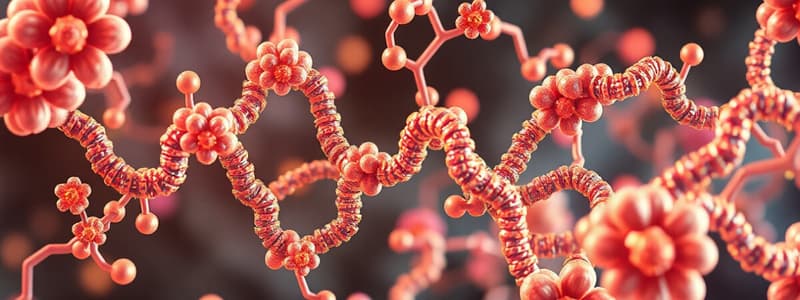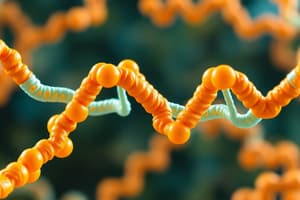Podcast
Questions and Answers
Which amine is produced from the amino acid Histidine?
Which amine is produced from the amino acid Histidine?
- Histamine (correct)
- Serotonin
- Tyramine
- Cadaverine
What occurs during the formation of a peptide bond?
What occurs during the formation of a peptide bond?
- Peptide bonds are formed between carbohydrates.
- Amino acids lose a carbon atom.
- An amine and a carboxylic acid condense with water loss. (correct)
- Water is added to form proteins.
Which amino acid can form disulfide linkages?
Which amino acid can form disulfide linkages?
- Glutamate
- Serotonin
- Cysteine (correct)
- Tyrosine
What is produced when amino acids react with alcohols?
What is produced when amino acids react with alcohols?
Which function is NOT associated with amino acids?
Which function is NOT associated with amino acids?
Which amino acids are purely glucogenic?
Which amino acids are purely glucogenic?
What is the primary characteristic of a zwitterion?
What is the primary characteristic of a zwitterion?
Which of the following amino acids can be both ketogenic and glucogenic?
Which of the following amino acids can be both ketogenic and glucogenic?
At what pH does an amino acid reach its isoelectric point?
At what pH does an amino acid reach its isoelectric point?
What happens to the -COO- group in an acidic solution?
What happens to the -COO- group in an acidic solution?
What is the result of the ninhydrin test for amino acids?
What is the result of the ninhydrin test for amino acids?
Which property is true for all amino acids except glycine?
Which property is true for all amino acids except glycine?
During decarboxylation of amino acids, what is primarily formed?
During decarboxylation of amino acids, what is primarily formed?
Which of the following amino acids is classified as a basic amino acid?
Which of the following amino acids is classified as a basic amino acid?
Which of these amino acids can be synthesized by the human body?
Which of these amino acids can be synthesized by the human body?
What characteristic defines an aromatic amino acid?
What characteristic defines an aromatic amino acid?
Which amino acid is considered purely ketogenic?
Which amino acid is considered purely ketogenic?
Among the following, which amino acid is classified as semi-essential?
Among the following, which amino acid is classified as semi-essential?
Which group of amino acids forms hydrogen bonds with water due to their side chains?
Which group of amino acids forms hydrogen bonds with water due to their side chains?
What type of amino acids are glutamic acid and aspartic acid classified as?
What type of amino acids are glutamic acid and aspartic acid classified as?
Which of the following amino acids contains an SH group?
Which of the following amino acids contains an SH group?
Which type of amino acid is characterized by having a hydroxyl group in its side chain?
Which type of amino acid is characterized by having a hydroxyl group in its side chain?
Which property distinguishes α-amino acids from other amino acids?
Which property distinguishes α-amino acids from other amino acids?
Which classification of amino acids involves the structural distinction based on the R group?
Which classification of amino acids involves the structural distinction based on the R group?
Which of the following amino acids is considered aromatic?
Which of the following amino acids is considered aromatic?
What type of amino acids includes those that have a carboxyl group in their side chain?
What type of amino acids includes those that have a carboxyl group in their side chain?
Which amino acid type is classified based on the presence of a hetero atom in the ring but not a benzene ring?
Which amino acid type is classified based on the presence of a hetero atom in the ring but not a benzene ring?
Which of the following amino acids is neutral and simple with no functional group in its side chain?
Which of the following amino acids is neutral and simple with no functional group in its side chain?
What is the configuration of naturally occurring amino acids in proteins?
What is the configuration of naturally occurring amino acids in proteins?
Flashcards
Amino Acid Classification by Polarity
Amino Acid Classification by Polarity
Amino acids are categorized based on the polarity of their side chains (R groups). Polar R groups can form hydrogen bonds with water, while non-polar R groups cannot.
Essential Amino Acids
Essential Amino Acids
Essential amino acids cannot be synthesized by the body and must be obtained from food. Their deficiency impacts health and protein synthesis.
Non-Essential Amino Acids
Non-Essential Amino Acids
Non-essential amino acids can be produced by the body and are not required in the diet.
Semi-Essential Amino Acids
Semi-Essential Amino Acids
Signup and view all the flashcards
Aromatic Amino Acids
Aromatic Amino Acids
Signup and view all the flashcards
Heterocyclic Amino Acids
Heterocyclic Amino Acids
Signup and view all the flashcards
Polar Amino Acids
Polar Amino Acids
Signup and view all the flashcards
Nonpolar Amino Acids
Nonpolar Amino Acids
Signup and view all the flashcards
Purely Ketogenic Amino Acid
Purely Ketogenic Amino Acid
Signup and view all the flashcards
Amino Acid
Amino Acid
Signup and view all the flashcards
Protein
Protein
Signup and view all the flashcards
α-Amino Acid
α-Amino Acid
Signup and view all the flashcards
L-Amino Acid
L-Amino Acid
Signup and view all the flashcards
Chirality (of amino acids)
Chirality (of amino acids)
Signup and view all the flashcards
Amino Acid Classification (by R-group)
Amino Acid Classification (by R-group)
Signup and view all the flashcards
Aliphatic Amino Acids
Aliphatic Amino Acids
Signup and view all the flashcards
Aromatic Amino Acids
Aromatic Amino Acids
Signup and view all the flashcards
Neutral Aliphatic Amino Acids
Neutral Aliphatic Amino Acids
Signup and view all the flashcards
Acidic Amino Acids
Acidic Amino Acids
Signup and view all the flashcards
Basic Amino Acids
Basic Amino Acids
Signup and view all the flashcards
Amino Acid Classification
Amino Acid Classification
Signup and view all the flashcards
Glucogenic Amino Acids
Glucogenic Amino Acids
Signup and view all the flashcards
Ketogenic Amino Acids
Ketogenic Amino Acids
Signup and view all the flashcards
Ketogenic and Glucogenic Amino Acids
Ketogenic and Glucogenic Amino Acids
Signup and view all the flashcards
Amino Acid Structure
Amino Acid Structure
Signup and view all the flashcards
Optical Isomers
Optical Isomers
Signup and view all the flashcards
Amino Acid Physical Properties
Amino Acid Physical Properties
Signup and view all the flashcards
Zwitterion
Zwitterion
Signup and view all the flashcards
Isoelectric Point (pI)
Isoelectric Point (pI)
Signup and view all the flashcards
Acid-Base Properties
Acid-Base Properties
Signup and view all the flashcards
Ninhydrin Test
Ninhydrin Test
Signup and view all the flashcards
Decarboxylation
Decarboxylation
Signup and view all the flashcards
Amino Acid Decarboxylation
Amino Acid Decarboxylation
Signup and view all the flashcards
Decarboxylation of Histidine
Decarboxylation of Histidine
Signup and view all the flashcards
Decarboxylation of Tyrosine
Decarboxylation of Tyrosine
Signup and view all the flashcards
Decarboxylation of Lysine
Decarboxylation of Lysine
Signup and view all the flashcards
Carboxylate Ion Formation
Carboxylate Ion Formation
Signup and view all the flashcards
Esterification
Esterification
Signup and view all the flashcards
Peptide Bond Formation
Peptide Bond Formation
Signup and view all the flashcards
Disulfide Linkage
Disulfide Linkage
Signup and view all the flashcards
Protein Formation
Protein Formation
Signup and view all the flashcards
L-α-amino acids
L-α-amino acids
Signup and view all the flashcards
Study Notes
Amino Acids
- Proteins are large molecules composed of 20 amino acids linked in long chains called polypeptides.
- Amino acids are the building blocks for proteins found in all living cells.
- There are about 300 amino acids that occur in nature.
- Only 20 amino acids enter protein synthesis.
- Amino acids in proteins are in the L configuration.
Amino Acid Structure
- Amino acids have an amino group (NH₂), a carboxyl group (COOH), and a side chain (R group) attached to a central carbon atom.
- The side chain (R group) differentiates the 20 different amino acids.
Amino Acids in Proteins
- All naturally occurring amino acids in proteins are α-amino acids.
- Amino acids occur in L-form (left-handed).
- All amino acids except glycine have four different groups attached to their α carbon, which makes them chiral.
Classification of Amino Acids
- Based on chemical structure (R group): Aliphatic (non-ring structure), Aromatic (benzene ring), Heterocyclic (ring with non-carbon atoms).
- Based on polarity: Polar (hydrophilic) or Nonpolar (hydrophobic).
- Based on nutritional requirements: Essential (cannot be synthesized by the body), Nonessential (can be synthesized by the body), Semi-essential (formed by the body but not in sufficient quantities in children).
- Based on metabolic properties: Purely ketogenic (only form ketone bodies), Purely glucogenic (only form glucose), ketogenic and glucogenic (form both).
Physical Properties
- Colorless and crystalline in nature
- Melting point above 200°C
- Soluble in polar solvents and insoluble in nonpolar solvents.
- Except glycine, all amino acids have optical isomers stable due to asymmetrical α carbon atoms.
- They can exhibit colloidal nature and denaturing properties, in addition to enzymatic activities.
Acid-Base Properties
- Amino acids exhibit ionic behavior at different pH levels.
- A zwitterion is formed when the carboxyl group loses a proton and the amino group gains one.
- Zwitterions have both positive and negative charges with a net charge of zero.
Isoelectric Point (pI)
- The pH at which an amino acid has no net electrical charge.
- Amino acids are amphoteric (having both acidic and basic properties).
- It depends on the chemical structure and polarity.
Chemical Properties
- Ninhydrin test: Used to detect amino acids.
- Decarboxylation: Removal of carboxyl groups from amino acids.
- Reaction with alkalis: Formation of carboxylate ions.
- Reaction with alcohols: Formation of esters.
- Formation of peptide bonds: Condensation of amino and carboxyl groups forming amides with the loss of water.
- Disulfide linkages: Covalent bonds formed between sulfur-containing amino acids (cysteine).
Functions of Amino Acids
- Participate in nerve transmission (e.g., glutamate, serotonin, dopamine).
- Biosynthesis of various compounds (porphyrins, purines, pyrimidines, urea).
- Synthesize hormones (e.g., thyroid hormones, adrenaline).
- Constituents of peptides, hormones, neurotransmitters, and neuromodulators.
Studying That Suits You
Use AI to generate personalized quizzes and flashcards to suit your learning preferences.




